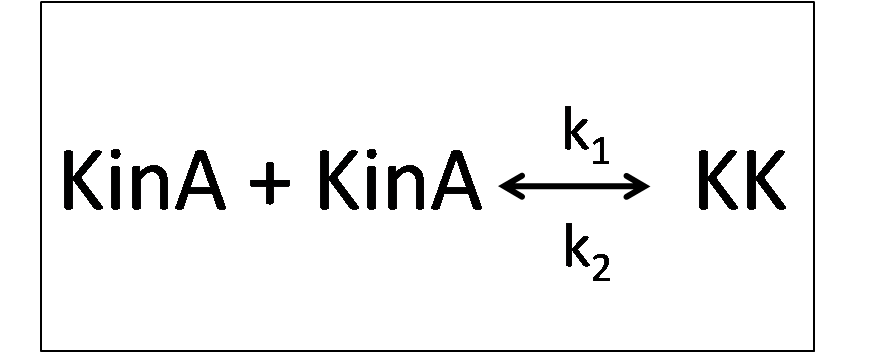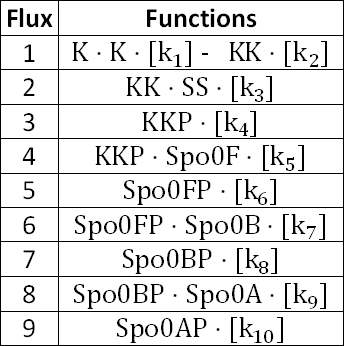Team:Newcastle/Modelling/SporulationTuning
From 2009.igem.org
(Replacing page with '{{:Team:Newcastle/CSS}} {{:Team:Newcastle/Header}} {{:Team:Newcastle/Left}} ==Sporulation Tuning Model== {{:Team:Newcastle/Footer}} {{:Team:Newcastle/Right}}') |
(→Sporulation Tuning Model) |
||
| Line 3: | Line 3: | ||
{{:Team:Newcastle/Left}} | {{:Team:Newcastle/Left}} | ||
==Sporulation Tuning Model== | ==Sporulation Tuning Model== | ||
| + | The expression of KinA has been modelled as seen above, therefore we can now proceed further into the Sporulation Tuning Model, which is built from the KinA Expression Model with COPASI. | ||
| + | |||
| + | To proceed with the modelling of our Sporulation Tuning Model, we have decided that in response to an unidentified stimuli, where KinA autophosphorylates and then donates its phosphate groups to the response regulator Spo0F, the unidentified stimuli will be termed as 'sporulation signal'.<sup>[4]</sup> | ||
| + | |||
| + | The following equations describe the model: | ||
| + | |||
| + | [[Image:TeamNewcastleSporeTuneEqn1.png|170px|center]] | ||
| + | <center>''Equation 1''</center> | ||
| + | |||
| + | |||
| + | [[Image:TeamNewcastleSporeTuneEqn2.png|130px|center]] | ||
| + | <center>''Equation 2''</center> | ||
| + | |||
| + | |||
| + | [[Image:TeamNewcastleSporeTuneEqn3.png|100px|center]] | ||
| + | <center>''Equation 3''</center> | ||
| + | |||
| + | |||
| + | As Spo0F lacks an output domain and is incapable of activating transcription; it serves only as an intermediary in the phosphorelay. The phosphotransferase Spo0B transfers the phosphate from Spo0F~P to Spo0A.<sup>[4]</sup> | ||
| + | |||
| + | [[Image:TeamNewcastleSporeTuneEqn4.png|230px|center]] | ||
| + | <center>''Equation 4''</center> | ||
| + | |||
| + | |||
| + | [[Image:TeamNewcastleSporeTuneEqn5.png|160px|center]] | ||
| + | <center>''Equation 5''</center> | ||
| + | |||
| + | |||
| + | [[Image:TeamNewcastleSporeTuneEqn6.png|280px|center]] | ||
| + | <center>''Equation 6''</center> | ||
| + | |||
| + | |||
| + | [[Image:TeamNewcastleSporeTuneEqn7.png|160px|center]] | ||
| + | <center>''Equation 7''</center> | ||
| + | |||
| + | |||
| + | [[Image:TeamNewcastleSporeTuneEqn8.png|280px|center]] | ||
| + | <center>''Equation 8''</center> | ||
| + | |||
| + | |||
| + | [[Image:TeamNewcastleSporeTuneEqn9.png|160px|center]] | ||
| + | <center>''Equation 9''</center> | ||
| + | |||
| + | |||
| + | With respect to Equations 1 to 9, as seen above, the corresponding fluxes are as follows: | ||
| + | [[Image:TeamNewcastleSporeTuneFluxes2.png|200px|center]] | ||
| + | <center>''Fluxes''</center> | ||
| + | |||
| + | |||
| + | The phophorylated proteins Spo0FP, Spo0BP and Spo0AP will go through degradation, and the following equations, Equation 10, 11 and 12 describes degradation. | ||
| + | |||
| + | [[Image:TeamNewcastleSporeTuneEqn10.png|80px|center]] | ||
| + | <center>''Equation 10''</center> | ||
| + | |||
| + | |||
| + | [[Image:TeamNewcastleSporeTuneEqn11.png|80px|center]] | ||
| + | <center>''Equation 11''</center> | ||
| + | |||
| + | |||
| + | [[Image:TeamNewcastleSporeTuneEqn12.png|80px|center]] | ||
| + | <center>''Equation 12''</center> | ||
Revision as of 16:14, 21 October 2009
Sporulation Tuning Model
The expression of KinA has been modelled as seen above, therefore we can now proceed further into the Sporulation Tuning Model, which is built from the KinA Expression Model with COPASI.
To proceed with the modelling of our Sporulation Tuning Model, we have decided that in response to an unidentified stimuli, where KinA autophosphorylates and then donates its phosphate groups to the response regulator Spo0F, the unidentified stimuli will be termed as 'sporulation signal'.[4]
The following equations describe the model:
As Spo0F lacks an output domain and is incapable of activating transcription; it serves only as an intermediary in the phosphorelay. The phosphotransferase Spo0B transfers the phosphate from Spo0F~P to Spo0A.[4]
With respect to Equations 1 to 9, as seen above, the corresponding fluxes are as follows:
The phophorylated proteins Spo0FP, Spo0BP and Spo0AP will go through degradation, and the following equations, Equation 10, 11 and 12 describes degradation.
News
Events
- 20 – 21 June 2009 - Europe workshop (London)
- 23 – 24 June 2009 - UK iGEM meetup (Edinburgh)
- 23 October Practice Presentation (Newcastle)
- 23 October T-shirts are ready
- 27 October Practice Presentation (Sunderland)
- 27 October Poster is ready
- 30 October – 2 November 2009 - Jamboree (Boston)
Social Net
 "
"


